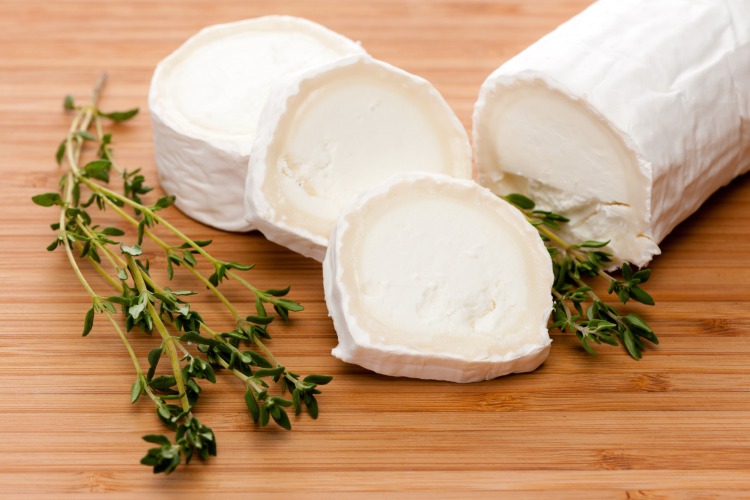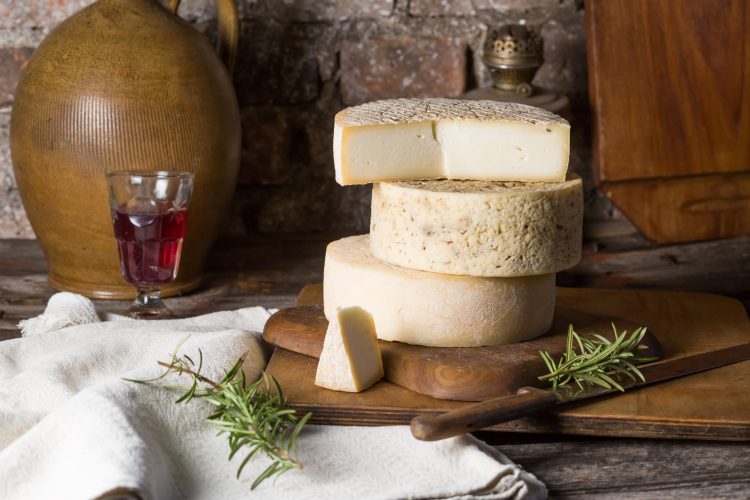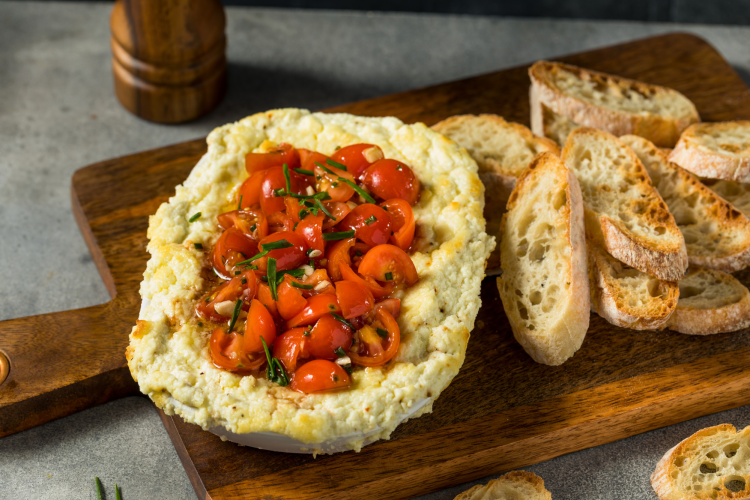An Introduction to Goat Cheese in 2025

What makes goat cheese so irresistible? Maybe it’s the smooth, tangy flavor, the way it melts into warm dishes or how it instantly upgrades a simple snack. No matter the reason, goat cheese has earned its spot as a kitchen staple — and it’s not going anywhere. While your grandparents might have only encountered basic chèvre, today's market offers an impressive spectrum of flavors and textures to explore.
Small-batch goat cheese brands are popping up everywhere, bringing us everything from truffle-infused medallions to honey-lavender spreads. To learn more about the different types, how they’re made and how to use them in your cooking, this guide will walk you through everything you need to know, from the basics to the best ways to enjoy them.
Jump to Section
- What Is Goat Cheese?
- The Best Ways to Eat Goat Cheese
- Best Goat Cheese Recipes
- Is Goat Cheese the Healthiest Cheese?
- Goat Cheese FAQs
What Is Goat Cheese?

Goat cheese is a creamy, tangy cheese made from goat’s milk. It’s been a staple in diets around the world for thousands of years, especially in regions where goats were easier to raise than cows. You might also see it labeled as chèvre, a common goat cheese name that comes from the French word for “goat.”
It’s the same delicious cheese, just with a little European flair. Its slightly tart taste comes from the natural properties of goat’s milk, which has smaller fat globules and different proteins than cow’s milk. This makes goat cheese not only easier to digest for some people but also gives it that signature zing.
The History of Goat Cheese
Goat cheese has been around for a long time, as goats were one of the earliest animals humans domesticated for milk. While cows need open pastures, goats can thrive on rocky hillsides and in rougher terrain, making them perfect companions for early communities. People were enjoying goat’s milk as far back as 5000 B.C. and it didn’t take long before someone figured out how to turn it into cheese.
One of the best-known regions for goat cheese is the Loire Valley in France. Back in the 8th century, the Moors introduced goats to the area and local farmers started using their milk to craft cheeses. As mentioned, the French word for goat is chèvre, which became the go-to name for their beloved goat cheese. Over time, chèvre became a staple, not only across France but also worldwide.
Fast forward to the U.S., and goat cheese didn’t really gain traction until the late 20th century. In 1979, Laura Chenel, a pioneering cheesemaker from California, learned traditional cheesemaking techniques in France and brought them home. Her fresh, tangy chèvre quickly won over American food lovers, especially in the culinary circles of the Bay Area and soon after, other creameries followed her lead.
Laura Chenel goat cheese is still a beloved staple today, known for its consistent quality and dedication to French-inspired techniques using American-sourced goat’s milk. Around the same time, Vermont also became a hub for high-quality goat cheese, with small dairies using their milk to craft artisan cheeses.
The state’s focus on sustainable farming and traditional methods helped build a strong reputation for excellence, with brands like Vermont Creamery leading the way.
These days, you can find goat cheese just about everywhere, from creamy logs in the grocery store to handcrafted wheels at your local farmers market. There are a myriad of goat cheese varieties worldwide, each with a unique texture and flavor profile. The goat cheese taste can range from bright and citrusy to rich, earthy and even slightly grassy, depending on how it’s made and what the goats were eating.
Speaking of flavor, the goat’s diet plays a huge role, just like grapes in winemaking. Fresh herbs, flowers and grasses can all influence the final product, making every wheel of cheese just a little different. That’s part of what makes goat cheese so exciting to cook with and so satisfying to explore.
Making goat cheese is pretty simple but still rooted in tradition. It starts with gently heating the milk and adding cultures and a coagulant, like rennet or lemon juice. Once the curds form, they’re scooped into cheesecloth and left to drain for several hours, sometimes even overnight. Then, a touch of salt is added for flavor and preservation. From here, the cheese can be eaten fresh or aged to develop deeper, more complex notes.
What Type of Cheese is Goat Cheese?

Most people are familiar with the fresh version of goat cheese, which you’ll usually see in soft, log-shaped packages at the grocery store. It’s creamy, rindless, spreadable and perfect for topping crackers, tossing into salads or mixing into warm pasta.
Fresh goat cheese is typically made to be enjoyed young, just a few days to weeks after production and you’ll find it in a range of variations — plain, rolled in herbs, crusted with pepper or infused with flavors like garlic, truffle or cranberry.
Then there's aged goat cheese, which has had time to mature and develop a firmer texture and more complex flavor. This kind holds up beautifully on cheese boards or grated over roasted veggies and pasta. Somewhere in the middle, you’ll find soft-ripened goat cheeses. These varieties have a soft, edible rind and develop deeper flavors as they age.
Some, like crottin or Valençay, grow a natural rind during the drying process, while others, like bûcheron or florette, develop a bloomy white rind, similar to Brie cheese, thanks to added mold cultures.
Regional specialties also add to the diversity of goat cheese. France, in particular, is home to some of the world’s most iconic styles. Rocamadour is soft and spreadable with a mild nuttiness that makes it a great intro for beginners, while Montrachet has a zesty citrus finish and a slightly chalky bite. Then there’s bûche de chèvre, a rolled log that’s often coated in herbs, ash, or spices for an extra layer of flavor and visual appeal.
What Does Goat’s Cheese Taste Like?
If you’ve ever had goat cheese, you know it brings a flavor all its own, especially when it’s fresh. The goat cheese taste is easy to spot: creamy and slightly tart, with a zippy kick that wakes up your taste buds.
Younger versions are soft and spreadable, perfect for smearing on crackers or toast. As it ages, though, it firms up and develops richer, deeper flavors, sometimes even a little earthy but in the best way.
Depending on how it’s made, you might notice a hint of sweetness, a touch of funk or a mellow savoriness that balances out the tang. It’s a cheese with personality, but not in an overpowering way. And if you’re looking for ways to use it? There’s no shortage of inspiration.
The Best Ways to Eat Goat Cheese

Goat cheese is one of those ingredients that can elevate almost any dish. You can spread it on warm toast, crumble it over salads or mix it into pasta for a tangy twist. And while wine gets all the cheese-pairing hype, goat cheese actually goes surprisingly well with beer. Thanks to its lower acidity and refreshing bubbles, beer is a great match that balances the creaminess of the cheese without overwhelming your taste buds.
What Is Goat Cheese Used For?
As we’ve established, goat cheese is super versatile and easy to work with, especially the soft kind that spreads easily. It makes a great base for crostini or bruschetta, especially when topped with bold flavors like olives, sun-dried tomatoes or a spoonful of fresh pesto. Since it has roots in Mediterranean cooking, goat cheese naturally pairs well with ingredients like garlic, olive oil and herbs.
Its unique flavor also works well with ingredients like roasted beets, mushrooms or even sweet potatoes. A go-to goat cheese recipe is the classic beet and goat cheese salad; simple, colorful and full of flavor.
You can also use goat cheese in unexpected ways, like swapping it for cream cheese in frosting. Mix it with honey and a hint of lavender, and you’ve got a delicious twist for cupcakes.
If you’re curious about comparisons of goat cheese vs feta, they’re both tangy and crumbly, but goat cheese is usually creamier and a bit milder. And for something totally different, try it in a small-batch goat cheese ice cream — it’s rich, a little savory and amazing with fruit desserts or on its own.
Best Goat Cheese Recipes
There are tons of simple and delicious ways to use goat cheese in everyday meals. No matter which types of goat cheese you have on hand, there’s always a way to make them shine in the kitchen. Here are a few easy ideas to get you started.
Warm Baked Goat Cheese Dip

To make this crowd-pleasing dip, just mix fresh goat cheese with a drizzle of balsamic glaze, fresh basil and a little olive oil. Pop it in the oven until it’s warm and bubbly, then serve it with toasted baguette slices or crackers.
This is the kind of goat cheese recipe you can prep ahead and bake just before guests arrive. Top with some cherry tomatoes if you're feeling fancy.
Goat Cheese Custard Cups
If you’re in the mood for something sweet, these little custard cups are perfect. Blend soft goat cheese with vanilla, lemon, butter and just a touch of sugar. Let it chill in the fridge for an hour, then top with fresh fruit and honey.
Eggplant and Goat Cheese Pesto Pizza
Goat cheese and pizza are a match made in flavor heaven. For this recipe, start with your favorite pizza crust and layer on cooked eggplant, dollops of basil pesto and chunks of creamy or crumbly goat cheese (whatever you have on hand works great). Sprinkle with a little Parmesan and bake until it’s golden.
Is Goat Cheese the Healthiest Cheese?

Goat cheese is full of beneficial nutrients like calcium, protein and healthy fats that support strong bones and overall wellness. One of the top goat cheese benefits is how easy it is to digest. Thanks to the type of fat and protein it contains, your body breaks it down faster than cow’s milk cheese, which means it may help you feel satisfied sooner and be gentler on your stomach.
It also has A2 casein, a protein that’s easier to tolerate for people sensitive to traditional dairy, and it’s packed with probiotics that support gut health. Plus, it’s typically lower in fat than many cheeses made from cow’s milk, though, like anything delicious, it’s best enjoyed in moderation. Whether you go for a soft chèvre or another popular goat cheese name, this flavorful cheese is an easy way to add a nutritious twist to your meals and snacks.
Goat Cheese FAQs
Is Brie a Goat Cheese?
Traditional Brie is typically made from cow's milk, which is what gives it the luxurious texture it's known for. But if you're exploring alternatives, you might be surprised to discover that goat milk Brie cheese exists, too.
This variation maintains the classic bloomy rind but offers a firmer texture and lighter, more refreshing flavor. It’s perfect if you're looking for something with a bit more character than cottage cheese but not as bold as a classic chèvre.
Why Can I Eat Goat Cheese but Not Cow?
Even though goat cheese still contains lactose, it has much less than cheese made from cow’s milk, which can make it easier to digest for some people. Another reason goat cheese may be gentler on the stomach is that it has different types of proteins.
Goat’s milk contains more A2 beta-casein, a form of casein that’s generally easier to digest and much less of the A1 beta-casein, which is more likely to cause inflammation or discomfort. This is why some people who can’t tolerate cow’s milk cheese often do just fine with goat cheese.
Goat cheese has so much to offer in the way of flavor, texture and versatility. It’s a deliciously simple way to elevate everyday meals and can even add a gourmet twist to your favorite recipes. Whether you're new to the world of chèvre or a longtime fan looking to expand your horizons, there's always something new to discover when it comes to goat cheese.
Be sure to sample different varieties and don’t be shy about experimenting with creative pairings in your kitchen. To learn even more, check out other experiences happening on Classpop!

